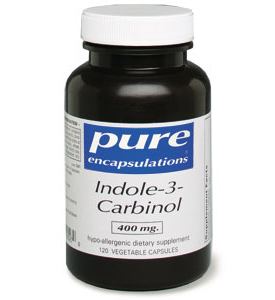Formula C9H9NO Appearance Off-white solid | Molar mass 147.18 g/mol | |
 | ||
Jerry hickey indole 3 carbinol supplement with dim
Indole-3-carbinol (C9H9NO) is produced by the breakdown of the glucosinolate glucobrassicin, which can be found at relatively high levels in cruciferous vegetables such as broccoli, cabbage, cauliflower, brussels sprouts, collard greens and kale. It is also available in dietary supplements. Indole-3-carbinol is the subject of on-going biomedical research into its possible anticarcinogenic, antioxidant, and anti-atherogenic effects. Research on indole-3-carbinol has been conducted primarily using laboratory animals and cultured cells. Limited and inconclusive human studies have been reported. A recent review of the biomedical research literature found that "evidence of an inverse association between cruciferous vegetable intake and breast or prostate cancer in humans is limited and inconsistent" and "larger randomized controlled trials are needed" to determine if supplemental indole-3-carbinol has health benefits.
Contents
- Jerry hickey indole 3 carbinol supplement with dim
- Indole 3 carbinol and cancer
- Systemic lupus erythematosus
- Effect in recurrent respiratory papillomatosis
- References
Indole-3-carbinol and cancer
Investigation of mechanisms by which consumption of indole-3-carbinol might influence cancer incidence focuses on its ability to alter estrogen metabolism and other cellular effects. Controlled studies have been performed on such animals as rats, mice, and rainbow trout, introducing various controlled levels of carcinogens, and levels of Indole-3-carbinol into their daily diet. Results showed dose-related decreases in tumor susceptibility due to Indole-3-carbinol (inferred by decreases in aflatoxin-DNA binding). The first direct evidence of pure anti-initiating activity by a natural anticarcinogen (indole-3-carbinol) found in human diet was claimed by Dashwood, et al., in 1989.
Indole-3-carbinol induces a G1 growth arrest of human reproductive cancer cells. This is potentially relevant to the prevention and treatment of cancer, as the G1 phase of cell growth occurs early in the cell life cycle, and, for most cells, is the major period of cell cycle during its lifespan. The G1 phase is marked by synthesis of various enzymes that are required in the next ("S") phase, including those needed for DNA replication.
Overuse of indole-3-carbinol supplements in the hope of preventing cancer may be unwise, as the hormone balance should be tested (via simple blood test) before regular consumption. Such caution is advised, due to its effect on estrogen levels (estrogen has a significant impact on brain function).
It promotes liver cancer in trout when it is combined with aflatoxin B1 and demotes metastasis.
Systemic lupus erythematosus
Indole-3-carbinol can shift estrogen metabolism towards less estrogenic metabolites. Systemic lupus erythematosus (SLE, or lupus), an autoimmune disease, is associated with estrogen. In a study using mice bred to develop lupus, indole-3-carbinol was fed to one group while another group was fed a standard mouse diet; the group fed the indole-3-carbinol diet lived longer and had fewer signs of disease.
Another study of lupus prone mice with indole-3-carbinol defined the mechanism for the improvement of their disease to be due to sequential blocks in the development of B and T cells of these mice. The maturation arrests resulted in a fall in autoantibody production, thought to be a crucial component of lupus causation. In addition, I3C supplementation of the disease prone mice led to a normalization of their T cell function.
Women with lupus can manifest a metabolic response to indole-3-carbinol and might also benefit from its antiestrogenic effects. Clinical trials are currently underway to determine the efficacy of treating human patients suffering from lupus with indole-3-carbinol.
Effect in recurrent respiratory papillomatosis
There is evidence suggesting that indole-3-carbinol may have an effect on human papillomavirus infected cells in both pediatrics and adult patients. Research is ongoing.
